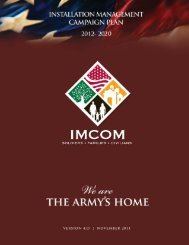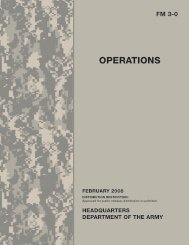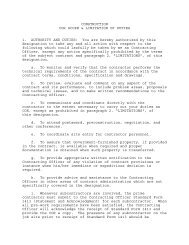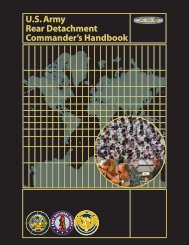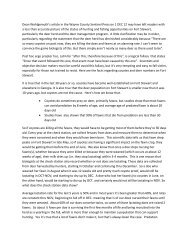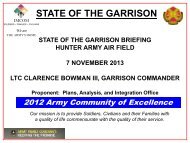3rd Infantry Division Operations - Fort Stewart - U.S. Army
3rd Infantry Division Operations - Fort Stewart - U.S. Army
3rd Infantry Division Operations - Fort Stewart - U.S. Army
Create successful ePaper yourself
Turn your PDF publications into a flip-book with our unique Google optimized e-Paper software.
4 <strong>3rd</strong> <strong>Infantry</strong> <strong>Division</strong> <strong>Operations</strong><br />
in order to return to a reasonable state of what it described as<br />
"combat readiness." Each brigade and the division's headquarters<br />
would receive new personnel, be issued new equipment,<br />
and then train in a set sequence. Many of its veterans had remained<br />
in the division following one, or even two, deployments<br />
since the war began in March of 2003. So, "getting ready" had<br />
become the norm for Soldiers in southeastern and far western<br />
Georgia.<br />
The division was well-practiced at deployments. There was<br />
a real sense of urgency. Operation Iraqi Freedom (OIF) was in<br />
its fourth year. That summer saw the continuance of violence<br />
that shocked onlookers. Iraq was boiling over in what some<br />
experts and media called a sectarian civil war. Masses of Iraqis<br />
had abandoned their homes in the nation's capitol. A decades<br />
old feud had been reignited following an attack on the al Askari<br />
"Golden Mosque" in Samarra in February of 2006. Retaliation<br />
by majority Shiites on minority Sunnis was nearly immediate<br />
and violence rippled outward across the land. Sunni and Shia<br />
Muslims were killing each other in large numbers. News reports<br />
said that headless bodies littered the streets. There were<br />
mass kidnappings and subsequent executions. Daily, brutal<br />
street battles were broadcast via television around the world.<br />
No one, not the new Shia-dominated government or the powerful<br />
coalition forces, seemed to be in control. It was as if no one<br />
was capable of holding Iraq together.<br />
The spiral downward toward complete failure promised<br />
dire strategic consequences for the U.S. and perhaps the entire<br />
world. Al-Qaeda had begun to experiment with horrifying<br />
weapons. The worldwide terror network had combined poisonous<br />
chlorine with explosives, to create an urban nightmare. Al-<br />
Qaeda had planted its fangs in the nation's flesh.<br />
Essential services were almost nonexistent. Disease fol-



